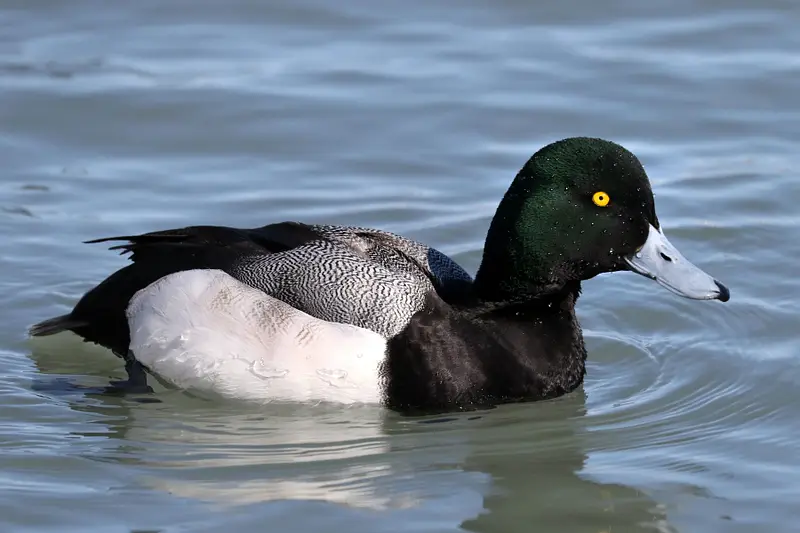About Greater Scaup
The Greater Scaup (Aythya marila) is a medium sized diving duck, known for its striking appearance and impressive migratory habits. With a wingspan of up to 34 inches and weighing between 1.5 to 2.5 pounds, the Greater Scaup is a robust and hardy species. These ducks are easily recognizable by their rounded heads and bright yellow eyes. Males display a glossy greenish-black head, a white underside, and a bluish-gray bill, while females are more subdued with brownish plumage and a distinctive white patch at the base of the bill.
Greater Scaup are often found in coastal and inland waters across North America, migrating from their breeding grounds in the northern tundra and boreal forests to wintering habitats along the coasts and large inland lakes. Known for their social nature, these birds form large flocks during migration and winter, often mixing with other diving duck species.

Identification
Greater Scaup can be identified by their rounded heads, bright yellow eyes, and distinctive coloration. Males have a glossy greenish-black head, a white underside, and a bluish-gray bill, while females are brown with a white patch at the base of the bill.
Breeding
Greater Scaup breed in the northern tundra and boreal forests, preferring wetlands with abundant vegetation for nesting. The female constructs a nest on the ground, usually near water, and lays a clutch of 6-9 eggs. She incubates the eggs alone and is responsible for rearing the ducklings, which can swim and feed themselves shortly after hatching.
Behavior
As diving ducks, they forage by diving underwater to feed on mollusks, crustaceans, aquatic insects, and plant material. Their ability to dive deep and stay submerged for extended periods makes them effective foragers in their aquatic habitats.
Habitat
During the breeding season, Greater Scaup inhabit wetlands in the northern tundra and boreal forests. In winter, they migrate to coastal bays, estuaries, and large inland lakes where they can find ample food and suitable conditions for diving and foraging. Their adaptability to various aquatic environments allows them to thrive across a broad range of habitats.
Migration
Greater Scaup are long-distance migrants, traveling from their breeding grounds in the northern tundra and boreal forests to wintering areas along the coasts and large inland lakes of North America. They migrate in large flocks and are often seen along the Atlantic and Pacific Flyways during their journeys.
No Data Found
How many days tracked
Lorem ipsum dolor sit amet, consectetur adipiscing elit. Ut elit tellus, luctus nec ullamcorper mattis, pulvinar dapibus leo.
Where are they now?
Lorem ipsum dolor sit amet, consectetur adipiscing elit. Ut elit tellus, luctus nec ullamcorper mattis, pulvinar dapibus leo.
No Data Found
No Data Found
Total Number of Data Points for Greater Scaup
Lorem ipsum dolor sit amet, consectetur adipiscing elit. Ut elit tellus, luctus nec ullamcorper mattis, pulvinar dapibus leo.
Start and End Date Tracking of Greater Scaup
Lorem ipsum dolor sit amet, consectetur adipiscing elit. Ut elit tellus, luctus nec ullamcorper mattis, pulvinar dapibus leo.
No Data Found
Overall Data from the Center
This is historical data from various sources. This data is available in its full form on our Duck Map in an easily visualizable format.
